Net 30 payment terms serve as a cornerstone in business transactions, providing a 30-day grace period for customers to settle their invoices. This billing arrangement is more than just a mere convenience; it stands as a strategic tool crucial for maintaining a healthy financial ecosystem in business, applicable to organizations of all sizes.
By allowing clients a 30-day payment window, companies not only manage operational liquidity but also nurture enduring client relationships. This timeframe is particularly significant as it aligns seamlessly with the standard monthly accounting cycle, facilitating streamlined financial planning for both parties involved.
Although seemingly straightforward, the concept of Net 30 plays a multifaceted role in business operations. It's about deferring payment and trust-building, managing cash flow, and fostering long-term business engagements.
In today’s dynamic market, where agility and customer relations are paramount, a nuanced understanding and effective implementation of Net 30 terms can be a game-changer, helping to significantly improve accounts payable efficiency.
To fully capitalize on Net 30 terms, be sure to get accounts payable solutions that help you manage revenue flow.

The Basics of Net 30 Payment Terms
At its core, Net 30 is a credit term used in business, stipulating that the payment for goods or services received is due within 30 calendar days of the invoice date. This period includes weekends and holidays, with the flexibility to start the 30-day countdown at the beginning of the next month for invoices issued towards the month's end. This flexibility often depends on the industry norms and the relationship between the buyer and seller.
Net terms for payment don't prevent customers from paying early. This flexibility, especially extended to new clients, can prove advantageous. However, precautions (such as mechanisms to prevent late payments) are essential.
In summation, the adoption of Net 30 terms reflects a mutual understanding and trust between vendor and customer. It's a system that hinges on the vendor's confidence in the client's adherence to the agreed timeframe and the customer's trust in the quality of the vendor's product or service.
Of course, some customers will pay immediately even with Net 30 terms. However, by offering trade credit under the Net 30 terms, businesses implicitly express their commitment to a sustainable and cooperative business relationship.
Advantages of Net 30 Payment Terms
Net 30 payment terms offer advantages to both sellers and buyers, contributing to the success of many businesses. Here is a breakdown of the main benefits for both sellers and buyers:
For Sellers:
Net 30 gives your clients very generous payment terms, which can help encourage customers. Some ways this benefits you are:
- Competitive Advantage:
Net 30 terms can position a seller more favorably with new clients, reflecting financial stability and customer-centricity. This flexibility can be a deciding factor for clients when choosing between suppliers, helping to remain competitive against other businesses. - Customer Loyalty:
By offering Net 30 terms, sellers cultivate loyalty and long-term relationships with clients. This arrangement demonstrates a level of trust and understanding, which can encourage repeat business and referrals. - Incentivizing Prompt Payments:
Sellers can combine Net 30 terms with early payment discounts, like 2/10 Net 30, where a discount is provided for payments made within 10 days. This approach accelerates cash inflow and incentivizes clients to clear their dues promptly.

For Buyers:
Net 30 payments on goods or services purchased can also be idea for buyers:
- Enhanced Cash Flow Management:
Net 30 offers buyers a cushion to managing finances without the pressure of immediate payment. This extra time can be crucial for small businesses and startups with tight cash flows. - Credit Building:
Businesses are no different from individuals when it comes to building their credit history and establishing their creditworthiness. Timely payments under Net 30 terms contribute to a positive credit history for businesses, aiding future credit applications or negotiations.
Potential Challenges and Solutions of Net 30 Payment Terms
While Net 30 terms offer advantages, they can also pose challenges that create cash flow problems, including the risk of non-payment, and administrative overhead. Here are some potential challenges and their solutions:
- Challenge: Delayed Cash Flow
Businesses may face cash constraints while waiting for payments, affecting their ability to cover operating expenses, make new a credit application, or invest in growth opportunities. This is especially a problem for smaller businesses.
⇒ Solution:
Incentivize customers to pay earlier by offering early payment discount offers (e.g., 2/10 Net 30, offering a 2 percent discount for payments made within 10 days). Additionally, implement late fees to discourage payment delays, ensuring a more predictable cash flow. However, you need to be careful not to offer too many discounts for early full payment, because this could affect your profit margin in the long run. - Challenge: Risk of Non-Payment
There's always a risk that a customer may default on their payment, leading to financial losses, increasing bad debt, and poor business credit.
⇒ Solution:
Conduct thorough credit checks on new customers and consider requiring upfront payments or shorter payment terms for higher-risk customers.
- Challenge: Administrative Overhead
Managing Net 30 accounts, particularly for multiple clients, can be an administrative burden.
⇒ Solution:
Leverage accounting software for automated invoicing, payment tracking, and reminders. This technology can significantly reduce the administrative load and help better manage the accounts.
Handling these challenges can be difficult, but it is vital for maintaining positive business credit and effective cash management. Just remember, while encouraging early payments, it's crucial to strike a balance to avoid affecting long-term profit margins.
Examples of Net 30 Payment Terms in Different Industries
The application of Net 30 terms varies across industries, showcasing its significance in diverse sectors:
Wholesale and Retail
Net 30 terms extend credit and aid retailers in managing inventory without immediate cash outlay. This flexibility is crucial, especially in industries with high inventory turnover rates and tight cash flows.
Freelancing and Consulting
Offering Net 30 terms attracts clients by providing payment flexibility. This is particularly beneficial when dealing with larger projects where a shorter payment term might be challenging for the client.
Manufacturing and Supply Chain
Net 30 terms play a crucial role in managing large-scale production and supply chain operations. They allow manufacturers and suppliers to plan and execute production schedules without being constrained by immediate payment requirements, which is particularly important for maintaining a smooth supply chain and meeting delivery deadlines.
Legal and Accounting Considerations
Clearly outlining Net 30 terms in contracts is vital to prevent misunderstandings and disputes. Key elements to include are precisely defining the 30-day period, outlining conditions for offering early payment discounts, and specifying penalties for late payments.
Accounting
From an accounting standpoint, Net 30 sales are recorded as accounts receivable, representing money owed by customers. Regularly reviewing both accounts payable and receivable helps assess financial health and identify potential bad debts, while accurate accounting and regular audits ensure effective receivables management. All of this together means that a business's cash balance remains healthy.
One of the best ways to do this is with good accounting automation.
Best Practices for Implementing Net 30 Payment Terms
Implementing Net 30 payment terms requires a blend of financial acumen, strategic foresight, and clear communication. Six key best practices include:
- Conduct Thorough Credit Checks: Evaluate client creditworthiness before extending Net 30 terms, utilizing credit reports or references to assess payment history and financial stability.
- Clear Communication: Before commencing business be sure to clearly communicate payment terms, including due dates, early payment discounts, and the consequences of late payments.
- Diverse Payment Terms: Offer a variety of payment terms, such as Net 15, Net 30, Net 60, or Net 90, to cater to different client needs and financial situations.
- Regular Follow-Ups: Implement a system for regular follow-ups and reminders for outstanding invoices, significantly improving on-time payments.
- Document Everything: Ensure that all agreed-upon terms are documented in contracts or invoices for legal protection and clear reference for both parties.
- Review and Adapt: Regularly review the effectiveness of Net 30 terms, adjusting based on client feedback and the company’s financial performance.
Comparing with Other Payment Terms
Net 30 is just one of the many payment terms used in business, each with its own merits. A brief comparison with other net payment terms includes:
Net 60 and Net 90: Longer payment terms extending the payment period to 60 or 90 days, suitable for industries with extended project durations or manufacturing types. While they offer more flexibility to the client, they also result in longer wait times for payment, which can impact the vendor’s cash flow.
Net 7 or Net 10: Shorter payment terms, where the customer pays within a week or 10 days, beneficial for small business owners dealing with cash shortages or needing quicker payment.
Immediate Payment or Net 0: Requires payment of net amount upon delivery of goods or completion of services, ensuring consistent cash flow but may be less attractive to clients who need payment flexibility.
Partial Payments or Installments: Breaks down the total amount due into smaller, more manageable payments over time, striking a balance between immediate payments and longer net terms. This can help buyers where full payment on delivery would be a challenge, with each payment or installment often having its own payment period.
FACT
|
|
When it comes to Net terms, the number signifies how long the customer has before the due date. The number of days includes all days, not just business days.
|
This covers all of the most common payment terms in the business world, but in reality you can set any due date you want for invoices. It's also worth considering credit terms that you might find relevant for your company. The choice among these terms should be based on the business’s cash flow needs, the industry's nature, and the customer's relationship.
In the end, finding the right invoice terms for your business is vital to help make sure that you stay on top of your finances.
Conclusion
In conclusion, Net 30 payment terms represent a vital component in business transactions, offering a balance between accommodating client flexibility and maintaining a steady flow of cash for businesses. In fact, as one of the most common invoice payment terms and when implemented correctly, Net 30 terms can go beyond the transactional realm and become a catalyst for nurturing trust and fostering long-term relationships with clients.
The enduring success of Net 30 terms lies in their adaptability. Regularly reviewing and fine-tuning these terms to align with the evolving needs of both the business and its clients ensures their continued relevance as a valuable tool in day-to-day business operations.
Takeaway
|
|
Net 30 payment terms, when handled with diligence and strategic foresight, transcend their role as a transactional tool, evolving into a dynamic asset for building trust and cultivating enduring relationships with clients.
|
Today, as businesses navigate the complexities of financial workflows, automation tools like Yooz offer comprehensive solutions to elevate accounting practices. To learn more about optimizing your accounting process and improving cash flow, explore how Yooz can entertain unique business requirements.
FAQs
How does Yooz's accounts payable solution accommodate Net 30 payment terms?
Can Yooz's accounts payable solution help organizations track and manage invoices with Net 30 payment terms efficiently?
How does Yooz's accounts payable solution handle exceptions or delays in meeting Net 30 payment terms?
Can Yooz's accounts payable solution integrate with accounting systems to ensure accurate recording and reporting of Net 30 payments?

-1.jpeg)







